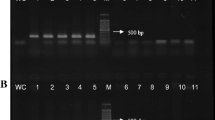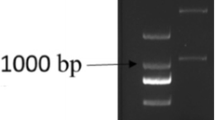Abstract
Erwinia amylovora [(Burrill)Winslowet al.] (Ea), the causal agent of fire blight, was detected in plant samples and pure bacterial cultures by means of PCR, IFAS and ELISA. Polyclonal antibodies ofNeogen Europe Ltd. were used for IFAS and PTA-ELISA and laboratory-generated primers EaF72 and EaR560 for PCR. Using theBIOLOG system and an immature pear fruit assay, identities of allEa strains were confirmed as the fire blight bacterium. In assays of pureEa cultures, PTA-ELISA, and both IFAS and PCR were sensitive to concentrations 106-105 and 105-104 CFU/mL, respectively. When saprophytic bacteria associated withEa in plant samples were tested as potentially cross-reacting bacteria, PTA-ELISA and IFAS gave 20 and 14 % cross-reactions, respectively. In plant samples, the presence ofEa was more reliably detected by IFAS (at a dilution of 1:1000) than by PTA-ELISA (to dilution 1:100). The capacity to detectEa might be increased using an optimized PCR, but for PCR prepared from infected plant samples it was necessary to use the bacterial DNA isolated with a DNeasy Plant Mini Kit (Qiagen). In this case the PCR was sensitive to a concentration of 105 CFU/mL. PCR was much more specific than either immunochemical technique, because no false positives were observed when primers EaF72 and EaR560 were used.
Similar content being viewed by others
Abbreviations
- DAS-ELISA:
-
double antibody sandwich enzyme-linked immunosorbent assay
- Ab:
-
antibody(ies)
- Ea :
-
Erwinia amylovora
- ELISA:
-
enzyme-linked immunosorbent assay
- ELISA-DASI:
-
ELISA-double antibody sandwich indirect
- FB:
-
fire blight
- FITC:
-
fluorescein isothiocyanate
- IF:
-
immunofluorescence
- IFAS:
-
indirect fluorescent antibody stain
- IgG-AP:
-
immunoglobulin-alkaline phosphatase
- IP-ELISA:
-
immunoprinting-ELISA
- PCR:
-
polymerase chain reaction
- PFGE:
-
pulse-field gel electrophoresis
- PTA-ELISA:
-
plate-trapped antigen-enzyme-linked immunosorbent assay
- SA:
-
slide agglutination
References
Anonymous: SMT project SMT-4-CT98-2252. Diagnostic protocols for organisms harmful to plants. Diagnosis ofErwinia amylovora;http://www.csl.gov.uk/science/organ/ph/diagpro/Erwinia.pdf.
Bereswill S., Pahl A., Bellemann P., Zeller W., Geider K.: Sensitive and species-species-specific detection ofErwinia amylovora by polymerase chain reaction analysis.Appl.Environ.Microbiol.58, 3522–3526 (1922).
Bereswill S., Bugert P., Bruchmueller I., Geider K.: Identification of the fire blight pathogen,Erwinia amylovora, by PCR assays with chromosomal DNA.Appl.Environ.Microbiol.61, 2636–2642 (1995).
Bereswill S., Jock S., Bellemann P., Geider K.: Identification ofErwinia amylovora by growth morphology on agar containing copper sulfate and by capsule staining with lecithin.Plant Dis.82, 158–164 (1998).
Cambra M., Olmos A., Gorris M.T., Duran N., Roman M.P., Camarasa E., Dasi M.A.: Sensitive detection of plant pathogen by using immobilized targets in tissue imprinted membranes. Abstr.4th Internat. Symp. EFPP, Bonn (Germany) 1996.
EPPO/CABI: Quarantine Pests for Europe, 2nd ed. (J.M. Smith, D.G. Mc Namara, P.R. Scott, M. Holderness, Eds), pp. 1001–1007. CAB International, Wallingford (UK) 1997.
Falkenstein H., Bellemann P., Walter S., Zeller W., Geider K.: Identification ofErwinia amylovora, the fireblight pathogen, by colony hybridization with DNA from plasmid pEA29.Appl.Environ.Microbiol.54, 2798–2802 (1988).
Gorris M.T., Camarasa E., Lopez M.M., Paulin J.P., Chartier R., Cambra M.: Production and characterization of monoclonal antibodies specific forErwinia amylovora and their use in different serological techniques.Acta Hortic.(Wageningen)411, 47–52 (1996a).
Gorris M.T., Cambra M., Llop P., López M.M., Lecomte P., Chartier R., Paulin J.P.: A sensitive and specific detection ofErwinia amylovora based on the ELISA-DASI enrichment method with monoclonal antibodies.Acta Hortic.(Wageningen)411, 41–45 (1996b).
Hutschemackers J., Verhoyen M.: Production of rat monoclonal antibodies to detectErwinia amylovora.Acta Hortic.(Wageningen)217, 71–76 (1987).
Hutschemackers J., Snacken F., Verhoyen M.: Utilization of rat monoclonal antibodies to detectErwinia amylovora.Acta Hortic. (Wageningen)273, 43–50 (1990).
Ishimaru C., Klos E.J.: New medium for detectingErwinia amylovora and its use in epidemiological studies.Phytopathology74, 1342–1345 (1984).
Jock S., Donat V., López M.M., Bazzi C., Geider K.: Following spread of fire blight in Western, Central and Southern Europe by molecular differentiation ofErwinia amylovora strains with PFGE analysis.Environ.Microbiol.4, 106–114 (2002).
Jones A.L., Geider K.: Gram-negative bacteria,Erwinia amylovora group, pp. 40–45 in N.W. Schaad, J.B. Jones, W. Chun (Eds):Laboratory Guide for Identification of Plant Pathogenic Bacteria, 3rd ed. American Phytopathological Society, St. Paul (USA) 2001.
Jones J.B., Chase A.R., Hariss G.K.: Evaluation of theBIOLOG GN microplate system for identification of some plant-pathogenic bacteria.Plant Dis.77, 553–558 (1993).
Kokošková B., Mráz I.: Reliability of diagnostic techniques forErwinia amylovora, the causative agent of fire blight disease.Folia Microbiol.50, 217–221 (2005).
Krejzar V., Kokošková B.:Erwinia amylovora — Biochemische Identifizierung mit derBIOLOG System, pp. 170–171 inBeitrage 2. Symp. Phytomedizin und Pflanzenschutz im Gartenbau, Wien (1999).
Lelliott R.A.: The diagnosis of fireblight (Erwinia amylovora) and some diseases caused byPseudomonas syringae.EPPO Bull.45, 27–34 (1967).
Lin C.P., Chen T.A., Wells J.M., Van der Zwet T.: Identification and detection ofErwinia amylovora with monoclonal antibodies.Phytopathology77, 376–380 (1987).
Lopez M.M., Cambra M., Aramburu J.M., Bolinches J.: Problems of detecting phytopathogenic bacteria by ELISA.Bull. OEPP/EPPO17, 113–117 (1987).
McLaughlin R.J., Roberts R.G.: Monoclonal antibodies againstErwinia amylovora characterization and evaluation of a mixture for detection by enzyme-linked immunosorbent assay.Phytopathology79, 610–613 (1989).
Miller T.D., Schroth M.N.: Monitoring the epiphytic population ofErwinia amylovora on pear with a selective medium.Phytopathology62, 1175–1182 (1972).
Momol M.T, Norelli J.L., Piccioni D.E., Momol E.A, Gustafson H.L., Cummins J.N., Aldwinckle H.S.: Internal movement ofErwinia amylovora through symptomless apple scion tissues into the rootstock.Plant Dis.82, 646–650 (1998).
OEPP/EPPO: Quarantine procedures. 40.Erwinia amylovora — sampling and test methods.OEPP/EPPO Bull.22, 225–232 (1992).
Pánková I., Kokošková B.: Sensitivity and specificity of monoclonal antibody Mn-Cs1 for detection and determination ofClavibacter michiganensis subsp.sepedonicus, the causal agent of bacterial ring rot of potato.Plant Protect.Sci.38, 117–124 (2002).
Pánková I., Mráz I., Petrzik K.: Determination of optimal concentration ofErwinia amylovora andPantoea agglomerans antigens in the slide agglutination reaction.Plant Protect.Sci.34, 59–62 (1998).
Salm H., Geider K.: Real-time PCR for detection and quantification ofErwinia amylovora, the causal agent of fireblight.Plant Pathol.53, 602–610 (2004).
Sasser M.: Identification of bacteria through fatty acids analysis, pp. 199–204 in F. Klement, K. Rudolf, D.C. Sands (Eds):Methods in Phytobacteriology. Akademiai Kiadó, Budapest 1990.
Schaad N.W., Sule S., van Vuurde J.W.L., Vruggink H., Alvarez A.M., Benedict A.A., de Wael L., van Laere O.: Serology, pp. 153–190 in F. Klement, K. Rudolf, D.C. Sands (Eds):Methods in Phytobacteriology. Akademiai Kiadó, Budapest 1990.
Sobiczewski P., Deckers T., Pulawska J.: Fire blight (Erwinia amylovora), p. 71 inSome Aspects of Epidemiology and Control. Research Institute of Pomology and Floriculture, Skierniewice (Poland) 1997.
Steinbrenner B., Zeller W, Bellemann P., Geider K.: DNA hybridization, a specific method for diagnosis of fire blight.Acta Hortic.(Wageningen)273, 91–93 (1990).
Taylor R.K., Guilford P.J., Clark R.G., Hale C.N., Forster R.L.S.: Detection ofErwinia amylovora in plant material using novel polymerase chain reaction (PCR) primers.N.Z.J.Crop Hortic.Sci.29, 35–43 (2001).
Van der Zwet T., Beer S.V.: Fire blight — its nature, prevention, and control.A Practical Guide to Integrated Disease Management. Agricultural Information Bulletin no. 631. US Department of Agriculture, Washington (DC) 1991.
Van der Zwet T., Wells J.M.: Application of fatty acid class analyses for the detection and identification ofErwinia amylovora.Acta Hortic.(Wageningen)338, 233 (1993).
Vaneste J.: Fire blight, the disease and its causative agentErwinia amylovora. CAB International, Wallingford (UK) 2000.
Zielke R., Schmidt A., Naumann K.: Comparison of different serological methods for the detection of the fire blight pathogen,Erwinia amylovora (Burrill)Winslow et al.Zbl.Mikrobiol.148, 379–391 (1993).
Author information
Authors and Affiliations
Corresponding author
Additional information
The work was supported by theMinistry of Agriculture of the Czech Republic (grant no. MZC 0002 700 603) and by theGrant Agency of the Academy of Sciences of the Czech Republic (grants no. 1QS 5005 10558 and AV 0Z 505 10513).
Rights and permissions
About this article
Cite this article
Kokošková, B., Mráz, I. & Hýblová, J. Comparison of specificity and sensitivity of immunochemical and molecular techniques for reliable detection ofErwinia amylovora . Folia Microbiol 52, 175–182 (2007). https://doi.org/10.1007/BF02932156
Received:
Revised:
Issue Date:
DOI: https://doi.org/10.1007/BF02932156




